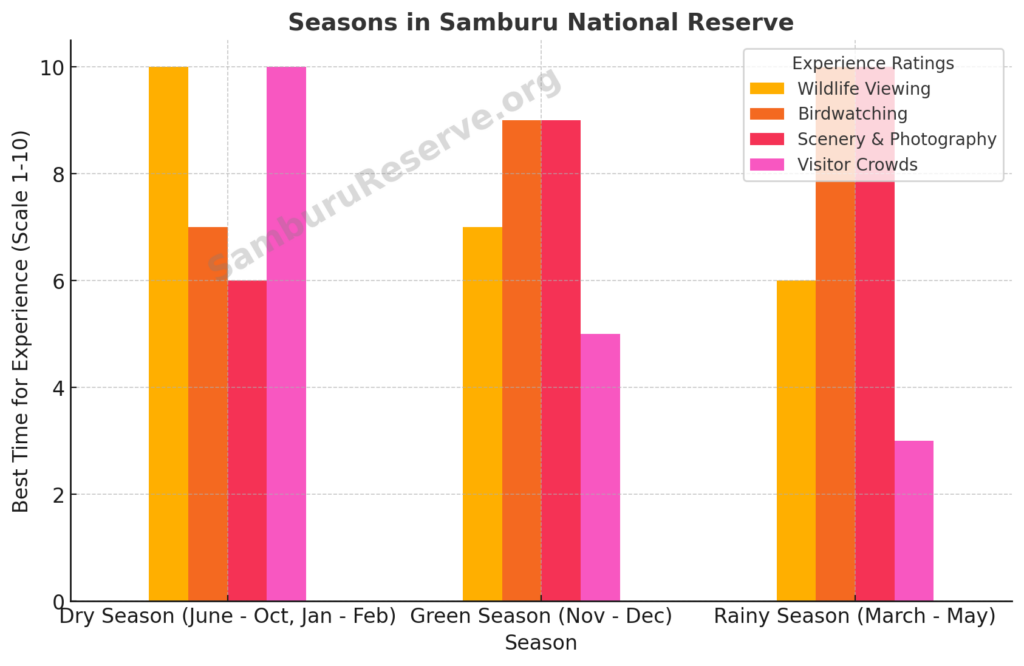Samburu National Reserve is a unique and rugged landscape, defined by its semi-arid climate, volcanic formations, and vital water sources. The geography and climate play a crucial role in shaping wildlife movement, plant life, and the overall safari experience.
In this guide, we explore Samburu’s climate patterns, its elevation, key rivers, volcanic landscapes, and the effects of drought and rainfall on the reserve’s ecosystems.
1. Climate Guide: What to Expect in Samburu
Samburu has a semi-arid climate, meaning it experiences hot temperatures year-round with distinct dry and rainy seasons.
Temperature & Weather Patterns
🌡 Daytime Temperatures: 28°C – 35°C (82°F – 95°F)
🌡 Nighttime Temperatures: 15°C – 22°C (59°F – 72°F)
Seasonal Breakdown
✔ Dry Season (June – October & January – February)
- Hot, sunny days with little to no rainfall.
- Best time for wildlife viewing as animals congregate near water sources.
- Clear skies, making it great for photography and stargazing.
✔ Rainy Season (March – May & November – December)
- Short rains: November – December (light, occasional showers).
- Long rains: March – May (heavier rains, transforming the landscape into lush greenery).
- Green season offers fewer tourists, better birdwatching, and stunning landscapes.
🔹 Tip: The best time for safaris is the dry season, but the rainy season brings lush scenery and baby animal sightings.

2. Ewaso Ng’iro River: Lifeline of Samburu
The Ewaso Ng’iro River is the most important water source in Samburu, sustaining wildlife and local communities.
Why is the Ewaso Ng’iro River Important?
🌊 Primary water source – Provides year-round water for elephants, lions, and other animals.
🌊 Creates riparian forests – Supports lush vegetation along its banks, home to rare birds and primates.
🌊 Attracts wildlife – Animals gather here during dry months, making it the best game-viewing area.
🌊 Cultural significance – The Samburu people depend on the river for livestock and daily life.
🔹 Best Wildlife Viewing Along the River:
📍 Buffalo Springs – Often crowded with elephants, zebras, and predators.
📍 West of Samburu Lodge – Popular drinking spot for lions and leopards.
📍 Kalama Conservancy – Ideal for spotting crocodiles and hippos.
3. Samburu’s Elevation: How It Affects Wildlife
Samburu National Reserve sits at an elevation of 800 to 1,230 meters (2,600 to 4,000 feet) above sea level.
How Elevation Shapes the Ecosystem
🏔 Lower Elevations (800-1,000m) – Hotter, drier areas with thorny bushes, acacia trees, and open savannahs.
🏔 Higher Elevations (1,000-1,230m) – Slightly cooler areas with denser vegetation, attracting herbivores.

Wildlife & Elevation Connection
- Elephants & Buffaloes stay near the Ewaso Ng’iro River.
- Leopards prefer rocky outcrops in higher elevations.
- Giraffes & Grevy’s Zebras roam lower-altitude savannahs.
🔹 Tip: The best panoramic views of Samburu’s diverse landscapes are from Koitogor Hill (1,230m).
4. How Samburu’s Wildlife Survives Droughts
Samburu faces frequent droughts, forcing animals to develop remarkable survival strategies.
Wildlife Adaptations to Drought
🐘 Elephants – Dig for underground water in dry riverbeds.
🦒 Giraffes – Can survive without drinking water for days, relying on moisture from leaves.
🦓 Grevy’s Zebras – Travel long distances in search of water, unlike common zebras.
🦁 Lions & Leopards – Hunt near shrinking waterholes, where prey is most vulnerable.
Effects of Drought on the Ecosystem
🔥 Longer dry periods – Rivers dry up, forcing wildlife migrations.
🔥 Increased competition for water – Leads to more predator-prey interactions near water sources.
🔥 Threat to plant life – Some acacia trees lose their leaves, affecting herbivores.
🔹 Tip: Visit during dry season (July – October) to witness dramatic survival interactions near water sources.
5. Rainy Seasons in Samburu: What to Expect
Samburu’s rainy seasons (March-May & November-December) bring lush vegetation, flowing rivers, and new wildlife births.
How Rain Affects the Safari Experience
🌧 Pros:
✔ Beautiful green landscapes and fewer tourists.
✔ Increased bird activity as migratory species arrive.
✔ Best time to see baby animals.
🌧 Cons:
✖ Some roads become muddy and difficult to drive on.
✖ Wildlife is harder to spot due to thick vegetation.
🔹 Tip: The rainy season is perfect for photographers who want lush scenery and dramatic skies.
6. Exploring Samburu’s Ancient Volcanic Formations
Samburu’s rugged terrain was shaped by ancient volcanic activity, leaving behind striking rock formations and hills.
Famous Volcanic Formations in Samburu
🌋 Mount Ololokwe – A sacred flat-topped mountain formed by ancient lava flows.
🌋 Koitogor Hill – A volcanic rock outcrop offering panoramic reserve views.
🌋 Suguta Valley – Features lava flows and eroded volcanic cones.
🔹 Tip: Hiking volcanic formations offers stunning sunrise and sunset views over Samburu’s landscape.
7. Why Koitogor Hill is a Must-See in Samburu
Koitogor Hill (1,230m above sea level) is one of the best viewpoints in Samburu, offering spectacular sunrise and sunset views.
Why Visit Koitogor Hill?
🏔 Best panoramic views of Samburu and Buffalo Springs.
🏔 Great for hiking with rewarding scenic trails.
🏔 High chance of spotting predators like leopards.
🔹 Tip: Plan a sunset hike for the most breathtaking golden-hour photos.
8. Water Sources of Samburu: A Vital Lifeline
Apart from the Ewaso Ng’iro River, Samburu relies on several seasonal waterholes and springs.
Key Water Sources in Samburu
💧 Ewaso Ng’iro River – Main year-round water source.
💧 Buffalo Springs – Natural springs supporting large wildlife populations.
💧 Kalama Waterhole – A man-made waterhole used by elephants and buffaloes.
🔹 Tip: Dry season safaris offer guaranteed wildlife sightings near these water sources.
Final Thoughts: How Geography & Climate Shape Samburu’s Safari Experience
Samburu’s climate, rivers, and volcanic landscapes create a unique ecosystem that shapes wildlife behavior and safari experiences.
Best Time for Different Experiences
| Experience | Best Season |
|---|---|
| Best Wildlife Viewing | Dry Season (June – October, Jan – Feb) |
| Birdwatching & Migratory Birds | Green Season (Nov – April) |
| Best Photography & Landscapes | Rainy Season (March – May, Nov – Dec) |
| Hiking & Rock Climbing | Year-Round (Dry Season Preferred) |
